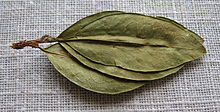- For other places with the same name, see Coca (disambiguation).

Coca (Erythroxylum coca) is a plant whose leaves have been traditionally used in a number of Andean cultures, notably in tea, chewing, and rituals, and remains in wide, legal use in the corresponding modern countries in South America. However, as a raw material for cocaine, coca leaves and derived products (unless decocainized) are illegal in the vast majority of countries, under the 1961 Single Convention on Narcotic Drugs.
Coca products may thus be consumed while in some South American countries, but should not be taken home as souvenirs, under penalty of often very severe drug trafficking laws, in some cases execution. This applies not only to the raw leaves, but to derived products, such as tea, which contain small amounts of cocaine. To be safe, do not bring coca home.
|
This article contains general advice, followed at the reader's own risk. None of it should be taken as legal or medical advice. |
Availability
[edit]Coca is primarily used in Bolivia, Peru, and Colombia, and is found to a lesser degree in Argentina, Chile, and Ecuador. Within these countries, it is associated with Andean regions, and availability and legality may vary – check country-specific articles. Where legal, it is widely available in grocery stores, convenience stores, herbal pharmacies, and tourist stores.
Note that while coca leaves and products may be legal in these several countries, cocaine is illegal and often carries very severe penalties in these countries.

Museums devoted to coca can be found: Museo de la Coca / Coca Museum[dead link] in La Paz, Bolivia; Museo de la Coca / Coca Museum in Cusco, Peru; and Museo de la Coca y Costumbres / Coca and Costumes Museum[dead link] in Puno, Peru. These provide information on coca, its culture, and a wide variety of coca-based products.
Health effects
[edit]Coca is often advocated for prevention of altitude sickness, but this is misleading. Coca does not speed acclimatization to altitude, but rather alleviates symptoms by acting as a stimulant, similarly to caffeine. The most common symptom of altitude sickness is a headache, and coca is reasonably effective in alleviating mild headaches, in the same way as caffeine (as in coffee or tea), though analgesics (such as aspirin, paracetamol, or ibuprofen) are more effective.
Consumption
[edit]Tea
[edit]

The most familiar preparation for tourists is coca tea, widely served in the Andes, and functioning very similarly to coffee or tea: a stimulating drink, primarily consumed in the morning.
Coca tea can either be prepared from loose leaves (drunk directly, or via a straw, like yerba mate), or from tea bags. Taste-wise, it is a rather mild herbal infusion.
Chewing
[edit]
Coca leaves are frequently chewed, by balling up leaves into the cheek and slowly chewing on them, or simply sucking. The stems may be removed, to reduce irritation of the cheek. To improve extraction of coca, a small amount of an alkaline substance may be added, traditionally ilucta (Peruvian: llipta), the ashes of quinoa or other plants, though baking soda may be used instead. However, while coca leaves are widely available in tourist stores, ilucta is much less available (at least in Peru), though it is sold at the Museo de la Coca[dead link] in Cusco.
Leaves are not digestible, so it is preferable to spit them out, though they are not harmful and can be swallowed (they’ll simply pass through your digestive system).
Other products
[edit]Coca is also used in various other products, notably hard candies (to suck on to alleviate altitude sickness), and general foodstuffs, including sweets and beer.
Rituals
[edit]
Hiking
[edit]When hiking in the Andes and crossing a pass, coca leaves may be added to cairns, as an alternative to a rock, and more conformant with the “Leave No Trace” philosophy.
Rituals vary, but traditionally in Peru one takes three leaves, blows on them while facing the way one came (in gratitude), then again while facing the way one is going (as request for safe passage), then again before placing them in the cairn, saying a prayer to the earth goddess Pachamama.
Reading
[edit]Coca leaves may be used for divination, somewhat similar to reading tea leaves in other cultures, but done with unused, dry leaves. Some indigenous people practice this, though they rarely speak English (usually Quechua or Aymara instead). They may speak Spanish; if you speak some too, you may ask “¿Hay alguien que sabe leer la coca?”. You may also do it yourself, in the usual way of divination (palm reading, tarot reading, etc.): based on knowledge of subject or gut feeling, make ambiguous or general statements about work, health, or love (e.g., “you’re attracted to someone, but have some reservations”).
Details vary, but it typically starts by selecting a handful of leaves (ensuring that they are flat), pointing them in the four cardinal directions, then having the subject blow on them three times. One leaf is selected to represent the subject and placed face up, while the others are scattered onto it. If they land face up (bright green), that is good, while if they land face down (pale green), that is bad, but if they do not land on the person’s leaf, they are disregarded. The proportion of good and bad leaves, together with other details, such as shape or position, can then be used to craft an answer.

